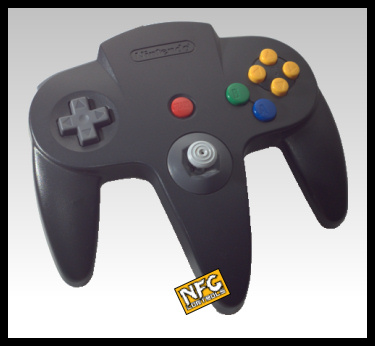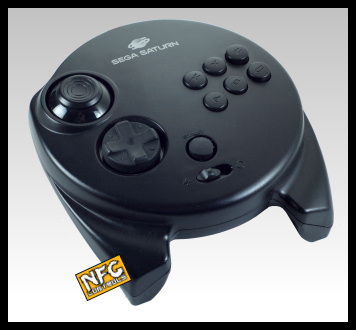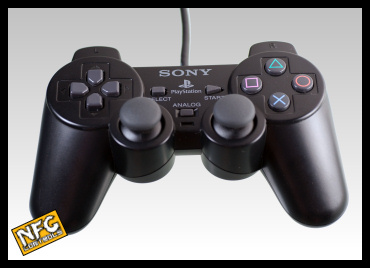Games
3D Controllers: The New Era
This is an old article from my old site, nfgcontrols dot com. Reposted for posterity (and because I wondered where it had gone…)
Analogue Controllers
Analogue controllers actually predate digital ones: the Magnavox Odyssey was the first console ever made, and it used an analogue paddle. The Apple II used analogue sticks, as did Atari’s 5200, and until the mid 1990s Windows PCs used analogue controllers almost exclusively. Post-Odyssey consoles went with digital though, almost exclusively for a very long time. There were aberrations: notably analogue paddles from Atari and Nintendo (via Taito), for example, and Micomsoft released an analogue stick for the MegaDrive.

Digital Inputs
Digital is limited: a digital pad has only four switches, so a player is either moving full speed or not at all, and in only 8 directions: up, down, left, right, and diagonals between them. The simple fact is digital controls were ideally suited to the kinds of 2D games offered by most consoles.
This all started to change when the Playstation, Saturn and N64 drew near, and 3D gaming became a living room reality. While you could play 3D games with a digital controller, anyone who has played a racing game with a joystick will tell you it’s not ideal.
Analogue controls were suddenly a good idea again as 3D games made it clear that a certain degree of subtlety was required. New vistas in game design required similarly advanced controllers and these analogue controls delivered. Instead of only four directions, there were hundreds, and players could now control their speed as well as direction.
Sega’s Saturn and Sony’s Playstation launched in 1994, and the N64 two years later in 1996. It was clear by the N64’s launch that the old digital controllers players had relied on for nearly 20 years were completely inadequate. All three companies recognized that the new 3D games required 3D controllers, and that year each introduced a different vision of the past future.
Without a doubt, some creative thinking was required to cram this extra dimension of control into existing pads.

Nintendo
Nintendo had the hard job of launching first, and the job of figuring out how to transition from digital to analogue fell to their talented engineers. Nintendo has historically been among the most adventurous game companies, reinventing many things with each new console, and when it came time to design the N64 pad they threw tradition to the wind.
Their 3D design seems to have started with a SNES-like foundation, with a d-pad on the left, A+B buttons on the right, and two shoulder buttons, but they quickly got a little weird.

The most striking feature of the N64 pad was the three-pronged design. The fitment of both a 2D d-pad and 3D stick had never been done before, and Nintendo’s solution was a wild one.
A player’s right hand was always on the right prong, and the left was on the left (for 2D) or centre (for 3D) prong depending on the game’s requirements. Though unusual, some games asked the player to use the left and centre prongs, for dual directional control.
Whenever the player used the centre prong, they could no longer reach the shoulder button, and so a Z trigger was added underneath the centre of the pad.
Early 3D games struggled with virtual camera placement, and it was a tough problem to solve. Nintendo’s solution was a dedicated group of four yellow buttons, collectively called the C button which gave the player control over the camera. These buttons were arranged in such a way that the pad could, when the C buttons were not required, function as a very serviceable 6-button pad.
Internally the stick mechanism used a clever optical mechanism with one critical flaw: the 3D stick was made of plastic, and used two plastic nubs as a fulcrum. Friction would wear down these nubs after a few short hours of play, causing the stick to become sloppy and less responsive very quickly.

Sega
Where Nintendo broke way out of the standard controller mold, Sega seemed to be more conservative. It seems as if their 3D pad was designed in a hurry, looking for all the world like a flat disc with handles on the bottom.
Most of the features matched their regular Saturn pad: the same six buttons on the right, the same d-pad on the left and… Some sort of big old nipple thing. Unlike the N64 which could, but rarely did use both digital and analogue controls at the same time, Sega’s 3D controller used a switch to choose between digital or analogue play.
Sega was unique in one way: they used a pair of analogue triggers on the front shoulders of the pad, giving players even more analogue control.

Despite its unattractive styling, the Saturn 3D pad is very comfortable, and players who bought the thing were rewarded with a very solid and reliable controller. One key area Sega drifted from Nintendo’s design was the internal analogue mechanism. Sega used Hall-effect sensors (more details) where Nintendo used traditional analogue wheels and gears (similar to an old ball-mouse or trackball).
Sega’s Hall-effect sensors utilized magnets and magnetic sensors to detect the position of the shoulder triggers and 3D nipple. Simple, effective, and they didn’t wear out in a few hours like Nintendo’s 3D stick did.

Sony
Sony embodied the Japanese innovation ethic perfectly, often choosing to build the same thing as the other guy but faster and better. The Playstation grew from their canceled SuperNES CD addon, and their original pad was not much different than the SNES controller, with little more than handles and an extra pair of shoulder buttons differentiating them. They didn’t stray far from this formula when they needed analogue controls, choosing to stick with the basic Playstation pad as a foundation.
Of course for Sony it wasn’t enough to be a little better, they pushed their low-risk envelope of innovation by adding two analogue sticks instead of the single one offered by Sega and Nintendo. Not only that, but Sony’s analogue sticks had buttons built in: they clicked when pushed straight down.
Sony’s first attempt was the Dual Analogue, offering 3 modes of functionality: a compatible digital-only mode, a mode emulating their large and poor-selling flight stick peripheral, and a new ‘dual analogue’ mode.

Sony continued to revise their design, incrementally tweaking the pad each time. The PS1 saw a new, slightly smaller Dual Shock pad with two vibrating motors built in (copying Nintendo’s Rumble Pak concept) and swapping the concave sticks for mushroom-topped convex ones.
Later, with the release of the PS2, they added analogue buttons to the mix. Throughout the life of the PS1 and PS2 Sony continued to follow Nintendo’s path by releasing coloured variants of the DualShock pad.
Good Times
Launching first involves taking all the risk: Nintendo’s pad blazed new ground with a single analogue control, Sega offered the same control with two additional triggers, and Sony offered two analogue controls with integrated buttons.
All three of these controllers were ideally suited to their purpose, and each company carried forward the lessons learned when designing their next consoles.
It was a good time to be a controller fetishist. It’s a shame most early 3D games weren’t as much fun as the controllers themselves.
--NFG
[ Mar 16 2020 ]
| Next Post | Navigation | Previous Post |
|---|



Name:
Email:
Website: